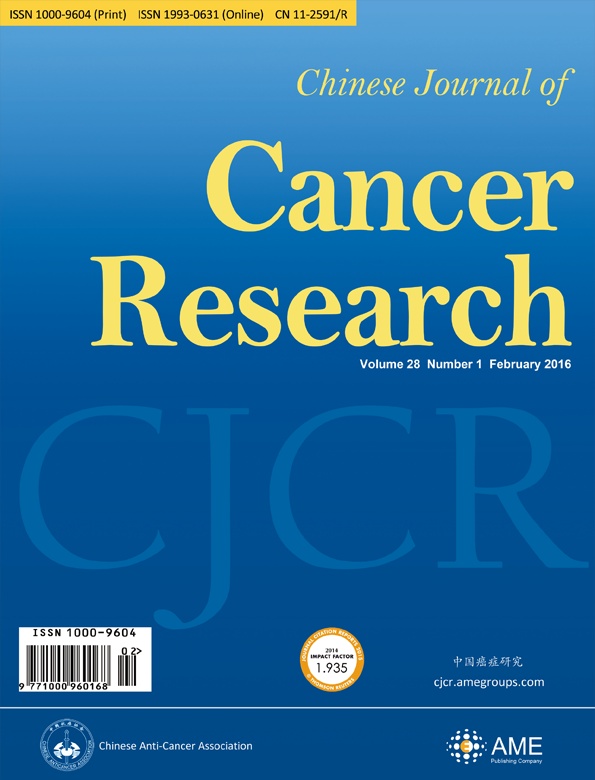Evaluation of COC183B2 antibody targeting ovarian cancer by near-infrared fluorescence imaging
IF 7
2区 医学
Q1 ONCOLOGY
引用次数: 5
Abstract
Objective To evaluate the imaging potential of a novel near-infrared (NIR) probe conjugated to COC183B2 monoclonal antibodies (MAb) in ovarian cancer (OC). Methods The expression of OC183B2 antigen in OC was determined by immunohistochemical (IHC) staining using tissue microarrays with the H-score system and immunofluorescence (IF) staining of tumor cell lines. Imaging probes with the NIR fluorescent dye cyanine 7 (Cy7) conjugated to COC183B2 Mab were chemically engineered. OC183B2-positive human OC cells (SKOV3-Luc) were injected subcutaneously into BALB/c nude mice. Bioluminescent imaging (BLI) was performed to detect tumor location and growth. COC183B2-Cy7 at 1.1, 3.3, 10, or 30 μg were used for in vivo fluorescence imaging, and phosphate-buffered saline (PBS), free Cy7 dye and mouse isotype immunoglobulin G (IgG)-Cy7 (delivered at the same doses as COC183B2-Cy7) were used as controls. Results The expression of OC183B2 with a high H-score was more prevalent in OC tissue than fallopian tube (FT) tissue. Among 417 OC patients, the expression of OC183B2 was significantly correlated with the histological subtype, histological grade, residual tumor size, relapse state and survival status. IF staining demonstrated that COC183B2 specifically expressed in SKOV3 cells but not HeLa cells. In vivo NIR fluorescence imaging indicated that COC183B2-Cy7 was mainly distributed in the xenograft and liver with optimal tumor-to-background (T/B) ratios in the xenograft at 30 μg dose. The highest fluorescent signals in the tumor were observed at 96 h post-injection (hpi). Ex vivo fluorescence imaging revealed the fluorescent signals mainly from the tumor and liver. IHC analysis confirmed that xenografts were OC183B2 positive. Conclusions COC183B2 is a good candidate for NIR fluorescence imaging and imaging-guided surgery in OC.近红外荧光成像评价靶向卵巢癌的COC183B2抗体
目的评价新型近红外(NIR)探针结合COC183B2单克隆抗体(MAb)在卵巢癌症(OC)中的成像潜力。方法采用组织芯片H核系统免疫组织化学(IHC)染色和肿瘤细胞系免疫荧光(IF)染色,检测OC183B2抗原在OC中的表达。化学工程化了具有与COC183B2 Mab偶联的NIR荧光染料花青7(Cy7)的成像探针。将OC183B2阳性的人OC细胞(SKOV3-Luc)皮下注射到BALB/c裸鼠中。进行生物发光成像(BLI)以检测肿瘤的位置和生长。1.1、3.3、10或30μg的COC183B2-Cy7用于体内荧光成像,磷酸盐缓冲盐水(PBS)、游离Cy7染料和小鼠同种型免疫球蛋白g(IgG)-Cy7(以与COC183B2-Cy7相同的剂量递送)用作对照。结果高H核OC183B2在OC组织中的表达高于输卵管组织。在417例OC患者中,OC183B2的表达与组织学亚型、组织学分级、残留肿瘤大小、复发状态和生存状态显著相关。IF染色显示COC183B2在SKOV3细胞中特异性表达,但在HeLa细胞中不特异性表达。体内近红外荧光成像表明,在30μg剂量下,COC183B2-Cy7主要分布在异种移植物和肝脏中,具有最佳的肿瘤与背景(T/B)比。肿瘤中的最高荧光信号在注射后96小时(hpi)观察到。离体荧光成像显示荧光信号主要来自肿瘤和肝脏。IHC分析证实异种移植物为OC183B2阳性。结论COC183B2是近红外荧光成像和影像引导下OC手术的良好候选者。
本文章由计算机程序翻译,如有差异,请以英文原文为准。
求助全文
约1分钟内获得全文
求助全文
来源期刊
自引率
9.80%
发文量
1726
审稿时长
4.5 months
期刊介绍:
Chinese Journal of Cancer Research (CJCR; Print ISSN: 1000-9604; Online ISSN:1993-0631) is published by AME Publishing Company in association with Chinese Anti-Cancer Association.It was launched in March 1995 as a quarterly publication and is now published bi-monthly since February 2013.
CJCR is published bi-monthly in English, and is an international journal devoted to the life sciences and medical sciences. It publishes peer-reviewed original articles of basic investigations and clinical observations, reviews and brief communications providing a forum for the recent experimental and clinical advances in cancer research. This journal is indexed in Science Citation Index Expanded (SCIE), PubMed/PubMed Central (PMC), Scopus, SciSearch, Chemistry Abstracts (CA), the Excerpta Medica/EMBASE, Chinainfo, CNKI, CSCI, etc.

 求助内容:
求助内容: 应助结果提醒方式:
应助结果提醒方式:


